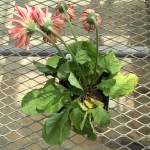Dig deeper ♣ Download fact-sheet pdf
Pythium & Phytophthora Root Rots
by Coralie Farinas, Nancy J. Taylor & Francesca Peduto Hand
Identification
Pythium and Phytophthora cause root and crown rots resulting in yellowing, stunting or wilting of the aboveground tissues of the plant. Foliar symptoms resemble nutrient deficiency because the compromised root system cannot take up the nutrients needed. Indeed, roots are soft and mushy due to the tissue decay and may appear water soaked, glassy, and dark brown. The root cortex separates easily at the touch leaving the vascular cylinder exposed. The rot may extend to the crown resulting in stem or crown rot or canker.
Symptoms caused by Pythium and Phytophthora are not unique and laboratory culturing is necessary to distinguish among pathogens. Samples should be submitted to a diagnostic laboratory for confirmatory diagnosis so that the right management recommendations are provided.
For assistance in identification, contact the C. Wayne Ellett Plant and Pest Diagnostic Clinic.
Management Guidelines
Integrated management practices are key to control Phytophthora and Pythium diseases in the greenhouse. The use of proper cultural practices combined with exclusion methods to avoid introduction of the pathogens in the greenhouse are essential to limit the diseases impact.
Sanitation:
- Clean and disinfect benches, pots, trays and any tool and equipment coming in contact with the plant or soil. If you have confirmed cases of infection, it is preferable not to recycle used pots and trays.
- Quarantine brought-in plants, and separate plants according to their origins.
- Scout thoroughly for disease to ensure early detection and remove and dispose of diseased plants immediately as well as any plant and soil debris.
- Keep hose ends off the ground to avoid contamination with soil particles that may be infected.
- Limit visitors’ access to production areas; disinfecting foot pads could be placed at the entrance of greenhouses
- Do not leave pots on bare soil, but use tarp to prevent contamination from the ground.
Cultural Practices:
- Do not overwater – select potting media with good draining capacity, preferably soilless.
- If field soil is used as a component of the potting medium, it must be steamed prior to utilization (180°F for at least 30 min).
- Do not place pots or flats in standing water.
- Fertilizers should be applied in strict accordance to the plant’s needs. High accumulation of salts increases root damage, which consequently favors pathogen infections.
- Plants should be spaced to avoid touching canopy and promote air-drying.
- Management of the irrigation system is key to control Pythium and Phytophthora. Particular attention should be paid to recycling irrigation systems. Many filtration systems options are available and will help in preventing pathogen dissemination (slow sand filtration, membrane filters, chlorine, ultraviolet light, etc.).
- Drip irrigation is preferred over overhead irrigation because minimizes water and soil splash and consequently pathogen spread.
Chemical control:
- Several fungicides are available to control Pythium and Phytophthora in the greenhouse and best results are obtained when they are applied preventatively.
- Misuse of fungicides has led to development of resistance in several pathogen populations. A high level of resistance has been observed to mefenoxam and metalaxyl (phenylamides) for both pathogens. Check with your State specialist or County Extension educator for the most updated information on products efficacy.
- To minimize the risk of fungicide resistance developing in your greenhouse, it is best to alternate fungicides with different mode of action (different FRAC codes).
Biological control:
- Some biocontrol agents have shown efficacy in controlling Pythium spp. in conditions of low disease pressure. Check with your State specialist or County Extension educator for the most updated information on products efficacy.




